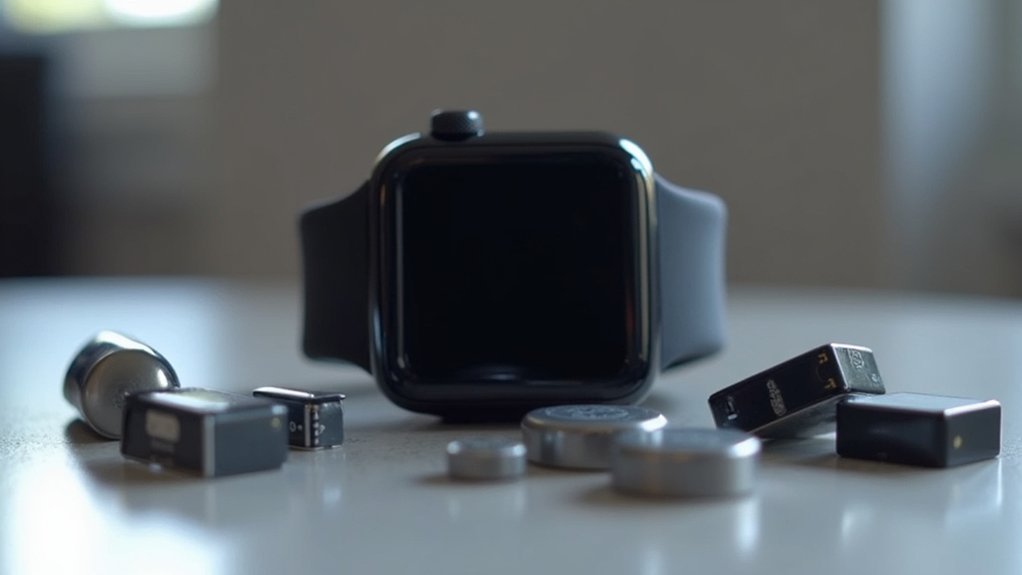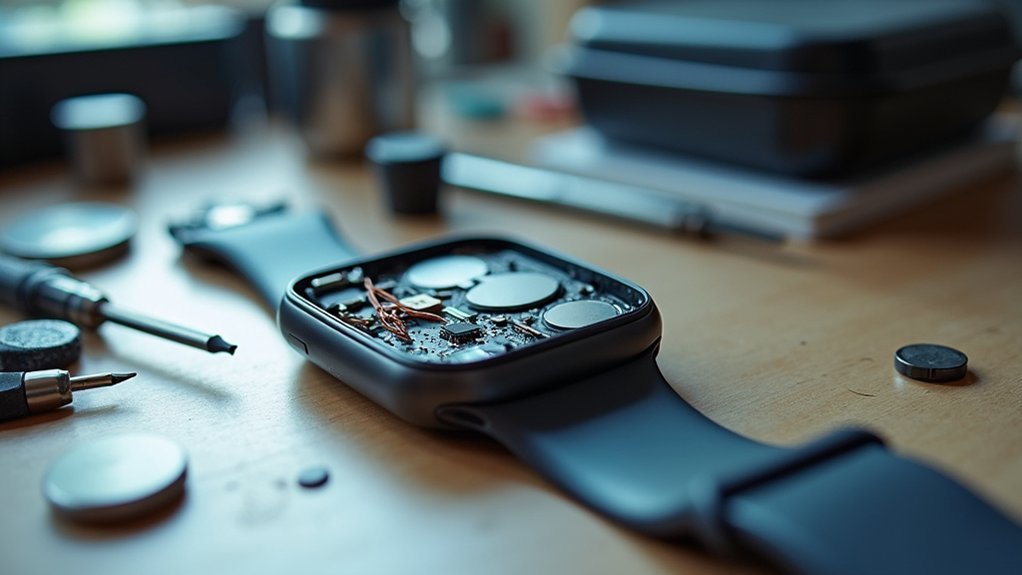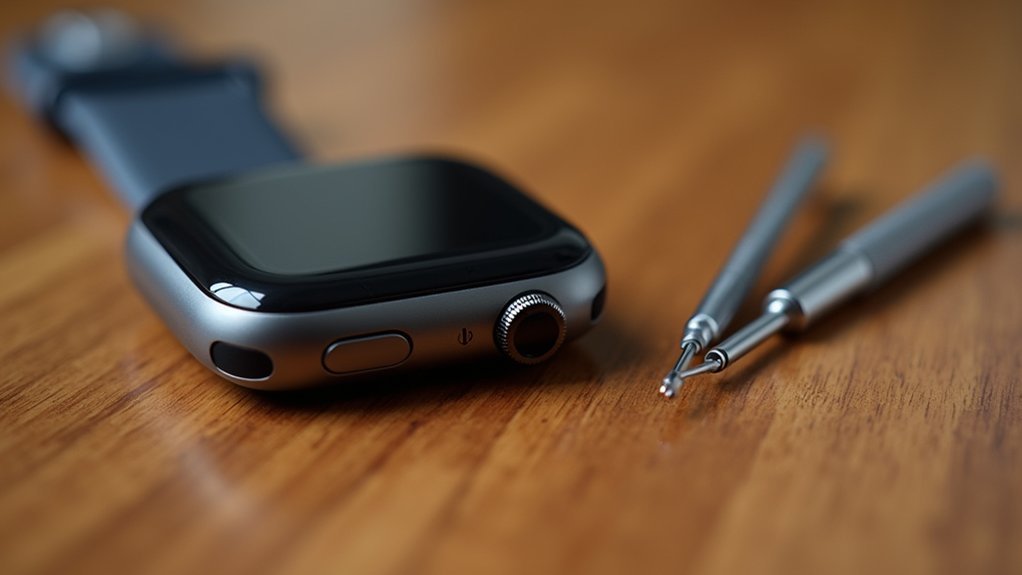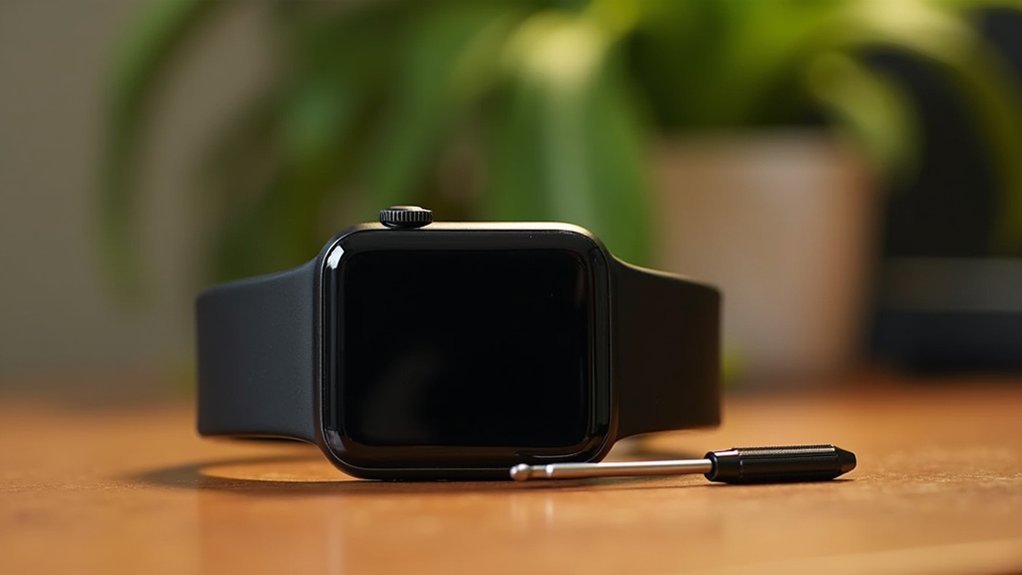Yes, smartwatch batteries can be replaced, though methods vary by model. Most premium watches like Apple Watch and Samsung Galaxy Watch use rechargeable lithium-ion batteries that last 1-2 years before needing replacement. You can choose between DIY replacement (requiring specialized tools) or professional service, with costs ranging from $79-$99 at authorized centers. Third-party repairs offer cheaper alternatives but may void warranties. Proper maintenance can greatly extend your battery’s lifespan before replacement becomes necessary.
Types of Smartwatch Batteries and Their Lifespan

The heart of every smartwatch lies in its battery technology. You’ll find several types powering today’s wearables, each with distinct advantages and lifespans.
Li-Ion batteries dominate high-end smartwatches due to their impressive energy density and light weight, typically lasting 300-500 charge cycles before degradation. Premium smartwatches like Apple Watch and Samsung Galaxy Watch generally incorporate higher capacity batteries ranging from 500mAh to 600mAh.
Powerful Li-Ion cells pack maximum energy into minimal space, fueling premium wearables through hundreds of recharge cycles.
Li-Po batteries offer greater flexibility for slim designs with improved safety and longevity (500-800 cycles), though at higher cost.
For simpler devices, non-rechargeable coin cells like the CR2032 provide 2-3 years of continuous operation.
Luxury analog-digital models often use silver oxide batteries, delivering stable voltage for 2-5 years.
Eco-conscious users might prefer solar-powered options from brands like Casio and Citizen, which offer potentially indefinite lifespans with proper secondary storage batteries.
Signs Your Smartwatch Battery Needs Replacement
Your smartwatch battery is likely failing when your once-full-day device suddenly needs charging multiple times daily.
Watch for dramatic drops in battery percentage during normal use or unexplained power-offs during routine activities like checking notifications or tracking workouts. If your smartwatch’s second hand begins to jump in intervals, this is a clear indicator of low battery power.
These performance issues typically worsen over time, with the watch eventually shutting down despite showing significant battery remaining.
Battery Life Deterioration
While all batteries eventually fail, recognizing the early signs of smartwatch battery deterioration can save you from unexpected power-downs during important moments.
The most obvious indicator is considerably shorter battery life – if your once all-day watch now dies before lunch, it’s likely failing.
Watch for decreased performance where your device can’t hold a charge properly or needs multiple daily recharges. Be suspicious if your screen display shows high battery levels but drains rapidly. This inconsistency signals internal issues.
Physical signs matter too. As batteries age, you might notice visible wear on your device coinciding with performance problems. Some models are designed with replaceable batteries while others have sealed units that cannot be changed.
Temperature extremes, frequent use of power-intensive features like GPS, and the natural aging process all contribute to deterioration. Most smartwatch batteries begin showing these symptoms after several years of regular use.
Unexpected Power-Offs
Unexpected power-offs represent the most serious indication that your smartwatch battery requires immediate replacement. If your device shuts down randomly despite showing adequate battery levels, your battery has likely deteriorated beyond normal function. This symptom often appears alongside other warning signs like device lag and erratic performance.
When your smartwatch struggles with basic operations or requires charging multiple times throughout the day, the battery cells have likely degraded considerably. These issues may worsen after physical damage or water exposure, both of which can compromise battery integrity. Similar to traditional watches, overlooking battery issues can lead to potential leakage and further damage to your smartwatch’s internal components.
You might also notice that fitness tracking features become unreliable and notifications arrive late or not at all. Don’t ignore these warning signs—continuing to use a failing battery can potentially damage other components in your device.
DIY vs. Professional Battery Replacement: Pros and Cons

When your smartwatch battery begins to fade, you’ll face an important decision: replace it yourself or seek professional help.
DIY replacement offers significant cost savings and convenience, letting you fix your watch on your schedule without appointments. Smartwatch batteries typically last 2 to 3 years before needing replacement, depending on usage patterns and device brand. However, it requires technical skills and risks voiding your warranty if done incorrectly.
Professional replacement provides expert service with proper tools and often includes warranty protection for the work. While more expensive and potentially requiring wait times, you’ll gain peace of mind knowing the job was done correctly.
- Save your beloved device from becoming electronic waste
- Feel the satisfaction of successfully repairing your own technology
- Avoid the frustration of damaging an expensive device through inexperience
- Experience the relief of having experts handle delicate components
Essential Tools for Smartwatch Battery Replacement
Replacing your smartwatch battery requires a core kit of precision tools including case openers, screwdrivers, and plastic tweezers to safely access internal components.
You’ll need to decide between investing in specialized tools for occasional use or multi-purpose alternatives that might serve broader repair needs.
Always prioritize safety equipment like anti-static mats and gloves to protect both yourself and your smartwatch’s sensitive electronics during the replacement process. Using plastic tweezers instead of metal ones is essential for safely handling batteries without causing shorts or damage to internal components.
Essential Tools: Core Kit
A successful smartwatch battery replacement begins with having the right tools at your disposal. When assembling your core kit, prioritize plastic tweezers to safely handle batteries without causing short circuits—metal tools can damage your device’s sensitive components. Bergeon makes quality options like the Bergeon 6460 plastic battery tweezer specifically designed for this purpose.
Add a precise case knife to carefully open your smartwatch without scratching its surface.
- Peace of mind: A watch band holder keeps your device steady, eliminating frustration when working with tiny components.
- Confidence booster: Having the correct replacement battery guarantees compatibility and peak performance.
- Safety assurance: Plastic tools prevent accidental shorts that could permanently damage your watch.
- Time saver: Proper instruction guides eliminate guesswork, saving hours of troubleshooting.
Specialized vs. Multi-purpose Options
Choosing between specialized and multi-purpose tools presents a critical decision for your smartwatch battery replacement project.
Model-specific kits with proprietary screwdriver bits (like Apple Watch or Samsung tri-wing) and pre-cut plastic shims reduce disassembly time by 15-30 minutes compared to universal alternatives.
While specialized tools cost 2-4× more ($30-$80 vs. $10-$20 for generic kits), they considerably decrease the risk of damaging delicate components.
Branded replacement batteries include pre-applied adhesive strips and proper thermistors, ensuring peak performance and maintaining water resistance.
If you’re working with budget models, standard precision screwdrivers and universal pry tools might suffice.
However, improvised alternatives like guitar picks increase reassembly error rates and may compromise waterproofing specifications.
Always remember to power off your smartwatch completely before attempting any battery replacement to prevent potential electrical damage.
The investment in specialized tools ultimately protects your device’s longevity.
Safety Equipment First
Before you even pick up your first tool, establishing proper safety measures for your smartwatch battery replacement determines both your personal safety and the success of your repair. Protecting against electrostatic discharge is critical—use plastic tweezers and consider non-conductive gloves when handling sensitive components.
Your workspace preparation is equally important. Secure your watch in a case holder and organize tiny screws in a dedicated tray to prevent costly losses or damage. Our comprehensive kit includes a bracelet holding block to provide stability during delicate battery replacement procedures.
- Frustration-saving tip: A magnetic screwdriver prevents those heart-stopping moments when screws disappear into carpet fibers.
- Peace-of-mind essential: Anti-static mats ground components, eliminating the risk of invisible circuit damage.
- Confidence booster: Battery testers confirm both your diagnosis and replacement solution.
- Sanity preserver: Proper lighting and magnification reveal details you’ll regret missing later.
Step-by-Step Battery Replacement Guide
Replacing your smartwatch battery requires careful preparation and precise execution to avoid damaging delicate internal components.
Begin by removing the watch bands and extracting case screws with the appropriate precision screwdriver. Carefully separate the back cover using opening tools at the seam.
Once inside, disconnect all flex cables from the motherboard using plastic tweezers or a spudger. Remove any motherboard retention screws and lift it to access the battery compartment.
Break the adhesive bond by inserting an opening pick at a 45-degree angle, then remove the old battery with plastic tweezers. For safety reasons, ensure you discharge the battery below 25% charge level before beginning the disassembly process.
Install your matching replacement battery by aligning the connector precisely. Apply fresh adhesive around the perimeter, ensuring flush positioning.
Reconnect all cables, secure the motherboard, and reassemble the case before testing through a complete charging cycle.
Brand-Specific Battery Replacement Considerations

When replacing your smartwatch battery, you’ll face different challenges based on whether your brand offers proprietary solutions or allows generic replacements.
Your warranty might be voided if you don’t use official service centers, though third-party options often cost considerably less than manufacturer services. The market offers numerous replacement options like Li-Polymer batteries for various smartwatch brands including Garmin, Samsung, Fitbit, Suunto, and Amazfit.
Apple and Garmin devices present the highest complexity for DIY replacement, while Fitbit and Casio watches are generally more accessible to the average user.
Proprietary vs. Generic Solutions
While traversing the smartwatch battery replacement landscape, you’ll quickly discover a complex divide between proprietary and generic solutions.
Manufacturer-specific batteries offer perfect compatibility but limited availability, often restricted to authorized repair centers. Remy Battery offers high-quality batteries compatible with popular brands like Apple, Fitbit, Garmin, and Samsung.
Meanwhile, third-party alternatives might save money but introduce performance risks and waterproofing concerns.
- Frustrating reality: Many newer Garmin and Apple models have no commercially available battery options outside official channels
- Alarming safety risks: Generic batteries frequently lack proper voltage regulation and safety certifications
- Disappointing performance: Third-party options typically deliver shorter battery life with 6-month warranties versus OEM longevity
- Heartbreaking damage: DIY repairs often permanently compromise your device’s water resistance and structural integrity
Warranty and Service Options
Maneuvering warranty and service options for smartwatch battery replacement reveals a complex landscape of fine print and brand-specific policies.
Most manufacturers exclude normal battery degradation from warranty coverage, only offering free replacements when capacity falls below specific thresholds—typically 80% for Apple devices.
You’ll find AppleCare+ and similar extended plans provide battery service at no extra cost, but only for original components.
Once you opt for third-party repairs, you’re generally voiding manufacturer warranties, though these services often provide their own one-year labor guarantees.
Insurance programs like Asurion and Geek Squad cover battery failures rather than gradual capacity loss. Notably, Geek Squad Protection includes a one-time battery replacement if your rechargeable battery fails during the coverage period.
When weighing options, consider that official repairs cost more than third-party alternatives, but preserve warranty status.
Always check your device’s built-in diagnostics to validate battery health before making claims.
Complexity by Brand
Battery replacement complexity varies dramatically across smartwatch brands, creating a landscape where your repair experience depends heavily on which device adorns your wrist.
Garmin watches like the Fenix series present significant challenges, with forum users documenting detailed DIY processes requiring special tools and patience. Grepow’s expertise in developing custom battery shapes can significantly simplify replacement processes for manufacturers and repair technicians.
Meanwhile, Apple’s sealed design necessitates professional intervention in most cases.
- Frustratingly complex: Apple Watches require specialized tools and careful adhesive removal that can intimidate even experienced DIYers.
- Surprisingly accessible: Some Fitbit models feature more user-friendly battery replacement designs.
- Deceptively difficult: Samsung watches vary dramatically by model—newer versions might trap you in adhesive nightmares.
- Reassuringly supported: Garmin, despite complexity, enjoys robust third-party battery availability across multiple suppliers.
Cost Analysis: New Battery vs. New Watch
When deciding whether to replace your smartwatch battery or purchase a new device altogether, you’ll need to weigh several financial factors.
Out-of-warranty battery replacements typically cost around $79 for Apple Watches, with Samsung offering similar pricing.
Consider that a new smartwatch might cost only slightly more than a battery replacement while providing improved features and longer battery life.
Third-party repairs are cheaper but lack warranties that authorized centers provide. Location and model type also influence costs considerably.
For Apple Watch Series 4 and newer models, battery replacement costs are higher at $99 out-of-warranty.
For perspective, traditional watch battery replacements range from $10-$30 for quartz models to $20-$150+ for mechanical timepieces.
If you’re facing frequent battery issues with an older smartwatch, investing in a new device often provides better long-term value than multiple replacements.
Common Pitfalls and How to Avoid Them
Steering through the smartwatch battery replacement process can be riddled with potential mistakes that might compromise your device’s functionality or lifespan. Using incompatible batteries or lacking proper tools are common errors that can permanently damage your smartwatch.
Before attempting a DIY replacement, ground yourself to prevent electrostatic discharge that could fry sensitive components. For Apple Watch owners specifically, be aware that battery replacements typically require sending your device to Apple for a reconditioned unit rather than a direct battery swap.
- Frustration awaits if you rush through reassembly, only to find your watch performing worse than before.
- Disappointment strikes when an incorrect battery drains quickly after your careful installation.
- Anxiety builds as you notice water resistance has been compromised after improper sealing.
- Regret follows realizing manufacturer warranty is now void due to unauthorized tampering.
Always check if your model allows user replacement before opening your device.
Maintaining Battery Health After Replacement
After successfully replacing your smartwatch battery, your work isn’t complete. Proper maintenance will maximize the lifespan of your new battery and guarantee peak performance. Regular partial charging rather than frequent complete discharges will help maintain lithium-ion battery health.
| Best Practice | Why It Matters |
|---|---|
| Keep temperature between 32°F-95°F | Extreme temperatures degrade battery cells rapidly |
| Avoid constant 100% charging | Reduces stress on battery chemistry |
| Perform occasional full charge cycles | Helps calibrate battery indicator accuracy |
| Use power-saving features | Reduces unnecessary battery drain |
| Update firmware regularly | Improves battery management algorithms |
Calibrate your new battery by charging it fully, then using it until it’s nearly depleted before recharging. This “teaches” your smartwatch to accurately display battery percentage. When not using your device for extended periods, store it at about 50% charge in a cool, dry place to preserve battery health.
Warranty Implications of Battery Replacement
Replacing your smartwatch battery yourself could potentially void the manufacturer’s warranty, so it’s crucial to understand your device’s specific warranty terms before proceeding. Different brands have varying policies—Fossil offers a 12-month goodwill battery guarantee, while iTouch explicitly states batteries can’t be replaced under warranty. For Fossil wearables, specifically, the one-year warranty only covers manufacturing defects, not battery issues after the initial period.
- Frustratingly, Fitbit doesn’t clearly outline battery replacement in their warranty, leaving consumers in a gray area.
- Relief comes with Fossil’s policy, which replaces watch batteries free within the first year.
- Disappointingly, most warranties become void if you open the device yourself.
- Surprisingly, Verizon’s extended warranty requires batteries to be greatly depleted before qualifying for replacement.
Check if your device is still under warranty before attempting DIY replacement, as manufacturer support might be your best option.
Environmentally Responsible Battery Disposal
When your smartwatch battery dies, proper disposal becomes essential to preventing environmental damage.
Lithium-ion batteries contain toxic materials that can contaminate soil and water if sent to landfills. They also pose fire hazards when crushed or punctured.
Instead of trashing your old battery, utilize dedicated recycling programs. Services like Call2Recycle offer convenient drop-off locations at major retailers including Home Depot and Lowe’s. You can easily find drop-off locations for your batteries through Call2Recycle’s locator service.
Many electronics stores also provide takeback programs for used batteries. Alternatively, check Earth911’s database to find local battery recyclers or hazardous waste collection sites.
Proper recycling allows valuable materials like cobalt, lithium, and nickel to be recovered and reused in new batteries, reducing environmental impact and energy consumption compared to mining new materials.
Your small effort makes a significant difference.
Frequently Asked Questions
Will Third-Party Batteries Affect My Smartwatch’s Performance?
Yes, third-party batteries can affect your smartwatch’s performance. They may cause inconsistent power delivery, random shutdowns, sensor inaccuracies, and shorter battery life if they don’t match your device’s specifications and safety standards.
Can Battery Replacement Restore Original Battery Life Completely?
No, replacement won’t fully restore original battery life. You’ll see significant improvement, but electrode wear and software updates mean even new batteries typically achieve 80-90% of your smartwatch’s original runtime capacity.
Are There Smartwatch Models With Easily User-Replaceable Batteries?
Yes, you’ll find some models with user-replaceable batteries. Older Garmin watches, some Pebble models, and basic fitness trackers typically offer easier battery replacement compared to newer sealed smartwatches from major manufacturers.
How Does Wireless Charging Affect Battery Replaceability?
Wireless charging doesn’t directly impact battery replaceability. However, smartwatches with this feature often have sealed designs, making DIY replacement harder. You’ll likely need professional help to replace batteries in wirelessly-charged models.
Does Battery Size Differ Between Smartwatch Generations of the Same Brand?
Yes, battery sizes often differ between smartwatch generations from the same brand. You’ll find variations due to design changes, new features, and technology advances that manufacturers implement to improve performance in newer models.
In Summary
Yes, you can replace your smartwatch battery, whether through DIY methods or professional service. While DIY replacement saves money, professional service guarantees proper installation. Remember to use the right tools, follow safety precautions, and dispose of old batteries responsibly. Regular maintenance will extend your new battery’s life. Don’t hesitate to tackle this project—with proper guidance, you’ll keep your smartwatch running for years to come.





Leave a Reply